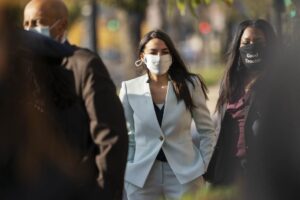The makers and distributors of opioids downplayed the painkillers’ danger and addiction risk while aggressively pushing the drugs on Long Island and raking in billions in profits, attorneys for Nassau and Suffolk counties argued Tuesday in court.
Lawyers for the plaintiffs in the landmark litigation spoke to jurors for the first time in opening statements in the sprawling lawsuit filed by the counties and New York Attorney General Letitia James.
Lawyers for the defendants, who have denied wrongdoing, are expected to present opening arguments Wednesday.
Internal company documents show that the defendants ignored the potential hazards of opioids, the plaintiff attorneys said as they kicked off the trial at Touro College in Central Islip. The companies used misleading marketing to persuade physicians and patients that their products were safe, the lawyers contended.
The defendants’ conduct, the attorneys said, fueled demand for black market heroin and fentanyl as well as the epidemic that has taken thousands of lives on Long Island.
“They have made money hand over fist while people in our community have died,” Hunter Shkolnik of Napoli Shkolnik, who is representing Nassau County, told jurors.
The drug manufacturers and distributors failed to report suspicious orders from pharmacies and other customers to federal and state regulators as required by law, John Oleske, senior enforcement counsel in the New York Attorney General’s Office, said in his opening argument. Some of the defendants failed to implement adequate systems to detect suspicious orders, he said.
“They failed to notify or inform proper authorities and their compliance efforts were basically nonexistent,” James said during a teleconference with reporters.
The New York opioid litigation is the first case of its kind in the nation to go before a jury, which is expected to hear from hundreds of witnesses over months.
Lawyers for the state and counties say they will prove that the defendants, which include pharmaceutical manufacturers Teva Pharmaceuticals, Allergan Inc. and Endo International, as well as distributors Cardinal Health, McKesson Corp. and AmerisourceBergen, created a “public nuisance” by pushing the drugs that created the opioid epidemic that has devastated Long Island families and communities.
If the plaintiffs prevail, a second trial will be held to determine damages that James said Tuesday should be dedicated to drug treatment, prevention and recovery support.
The lawsuit could set a template for a future national settlement with drug manufacturers and distributors, according to officials.
Drug companies shipped more opioid pills between 2006 and 2014 to Suffolk than any other of New York’s 62 counties, according to Jayne Conroy of Simmons Hanly Conroy, who represents Suffolk County.
Nassau was fourth on that list, behind Erie and New York counties. She said the evidence against the defendants is overwhelming.
“We have so many smoking guns,” she told reporters during a break. “We have all the evidence we need.”
Conroy told the jury the epidemic began in the 1990s, when OxyContin manufacturer Purdue Pharma — which has filed for bankruptcy and is not a defendant in this case — began marketing powerful painkillers designed for cancer patients and others nearing the end of thier lives as medication for backaches, headaches and other everyday ailments.
“Others jumped on the bandwagon,” Conroy said. “They saw Purdue’s success and they wanted a piece of the action.”
Doctors who expressed concerns that their patients were becoming addicted to powerful opioids were told that patients with pain could not become hooked on the drugs and were instead suffering from “pseudoaddiction,” a made-up condition. The cure for pseudoaddiction, Conroy said the defendants told doctors, was more pain medication.
“Sales went through the roof,” Conroy said.
Shkolnik told the jury that opioid users need ever-increasing dosages to maintain the effects of the drug, and when users on Long Island could not obtain enough prescription drugs, they turned to heroin, fentanyl and other drugs. Those drugs, in turn, fueled the overdose deaths and misery that has haunted many Long Island communities in recent years.
“Many people think this is a problem of people that take opioids and doctors who prescribe them and really the problem rests with the manufacturers who changed the marketing and with the distributors who don’t check the millions and millions of pills that go our their doors,” Conroy said outside of court.
“I think when the American public understands the way the industry works, they will begin to appreciate where the problem began,” she said.



















